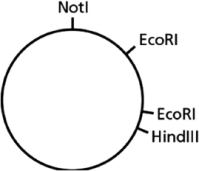Course
Cell Biology
Study Pack
Set 10 Analyzing The Structure And Function Of Genes
Question 1
(Multiple Choice)
Free
Figure 10-13 depicts a strategy by which a DNA fragment produced by cutting with the EcoRI restriction nuclease can be joined to a DNA fragment produced by cutting DNA with the HaeIII restriction nuclease.  Figure 10-13
Figure 10-13
Note that cutting DNA with EcoRI produces a staggered end, whereas cutting DNA with HaeIII produces a blunt end.Why must polymerase be added in this reaction?
 Figure 10-13
Figure 10-13Note that cutting DNA with EcoRI produces a staggered end, whereas cutting DNA with HaeIII produces a blunt end.Why must polymerase be added in this reaction?
A)Polymerase will fill in the staggered end to create a blunt end.
B)Polymerase is needed to seal nicks in the DNA backbone.
C)Polymerase will add nucleotides to the end produced by the HaeIII restriction nuclease.
D)Without polymerase, there will not be enough energy for the reaction to proceed.
Answer
Question 2
(Multiple Choice)
Free
You have a piece of circular DNA that can be cut by the restriction nucleases EcoRI, HindIII, and NotI, as indicated in Figure 10-6.  Figure 10-6
Figure 10-6
Which of the following statements is FALSE?
 Figure 10-6
Figure 10-6Which of the following statements is FALSE?
A)One piece of DNA will be obtained when this DNA is cut by NotI.
B)A piece of DNA that cannot be cut by EcoRI will be obtained by cutting this DNA with both NotI and HindIII.
C)Two DNA fragments that cannot be cut by HindIII will be obtained when this DNA is cut by EcoRI and NotI.
D)Two DNA fragments of unequal size will be created when this DNA is cut by both HindIII and EcoRI.
Answer
Question 3
(Multiple Choice)
Free
Figure 10-12 shows the cleavage sites of several restriction nucleases.  Figure 10-12
Figure 10-12
You cut a vector using the PciI restriction nuclease.Which of the following restriction nucleases will generate a fragment that can be ligated into this cut vector with the addition of only ligase and ATP?
 Figure 10-12
Figure 10-12You cut a vector using the PciI restriction nuclease.Which of the following restriction nucleases will generate a fragment that can be ligated into this cut vector with the addition of only ligase and ATP?
A)HindIII
B)NcoI
C)MmeI
D)NspV
Answer